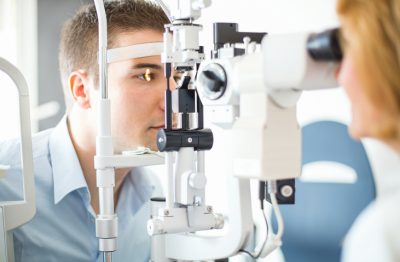Cardiologist Andalusia: Holistic Method to Heart and Eye Wellness
Cardiologist Andalusia: Holistic Method to Heart and Eye Wellness
Blog Article
Understanding the Various Vision Modification Procedures Available for Clearer Sight
In the realm of vision correction treatments, a plethora of choices exist to deal with refractive errors and give people with clearer view. From the commonly recognized LASIK surgery to much less invasive procedures like PRK and implantable lenses, the area of ophthalmology uses a variety of techniques customized to match different needs and choices. Each treatment includes its own set of factors to consider, benefits, and prospective dangers. Comprehending the nuances of these vision improvement approaches is important for making informed decisions regarding one's aesthetic health. Let's check out the ins and outs of these treatments and clarified the path to achieving improved vision clearness.
LASIK Surgical Procedure
LASIK surgery is a common refractive treatment made use of to correct vision problems such as astigmatism, nearsightedness, and farsightedness. This medical method, which stands for Laser-Assisted in Situ Keratomileusis, intends to reshape the cornea to improve how light is concentrated on the retina, inevitably improving vision clarity.
One of the key benefits of LASIK surgery is the fast enhancement in vision experienced by people. Lots of people discover a significant improvement in their sight quickly after the treatment. Furthermore, most people report marginal pain and pain throughout the surgical treatment and recuperation duration. The recovery time for LASIK is reasonably fast, with numerous people returning to their daily tasks within a day or two post-operation. In general, LASIK surgery is a preferred option for people looking for a long-term option for their vision problems.
PRK Procedure

PRK is an appropriate option for people with thin corneas or those at a greater risk of eye injuries, as it does not include developing a corneal flap. The healing procedure for PRK is slightly longer contrasted to LASIK, as the epithelium needs time to restore. Clients may experience pain and blurry vision for a few days complying with the treatment.
Despite the longer recovery time, PRK can produce outstanding lead to vision improvement, making it a valuable alternative for those that might not appropriate candidates for LASIK surgery. - Cardiologist Andalusia
Implantable Lenses
In comparison to PRK where the cornea is reshaped directly, implantable lenses offer an additional approach for dealing with vision by putting synthetic lenses inside the eye. This procedure is especially helpful for people with high degrees of astigmatism, nearsightedness, or farsightedness that might not be ideal prospects for laser surgical procedures like LASIK or PRK.
Implantable lenses, also known look at here as phakic intraocular lenses, job by supplementing the eye's natural lens with a synthetic one. These lenses can be placed before the natural lens (anterior chamber) or behind the iris and before the natural lens (posterior chamber) By adjusting the power and positioning of these lenses, eye doctors can successfully correct refractive mistakes and improve visual skill.
One advantage of implantable lenses is that they are exchangeable and detachable, offering flexibility for future changes. Nevertheless, as with any kind of surgical procedure, there are dangers involved, such as infection or cataract formation. Patients considering implantable lenses need to speak with an eye care expert to identify the most ideal choice based upon their private needs and eye wellness.
Corneal Rings

The procedure for placing corneal rings is minimally intrusive and reasonably quick, commonly performed as an outpatient procedure. During the surgical procedure, the eye doctor makes a small cut in the cornea and inserts the rings at a details depth. When in position, the rings aid to improve the cornea, providing a smoother surface for light to go into the eye, which can lead to more clear vision.
Corneal rings are considered a reversible procedure, as they can be removed or replaced if required. While they may not entirely remove the demand for glasses or call lenses, corneal rings can considerably boost vision top quality and general visual comfort for individuals with keratoconus or various other corneal abnormalities.
Refractive Lens Exchange
Adhering to the modification of corneal irregularities with treatments like corneal rings, one more vision adjustment technique that can address refractive errors is Refractive Lens Exchange (RLE) RLE is an operation that involves changing the eye's natural lens with a synthetic intraocular lens (IOL) to correct refractive mistakes such as presbyopia, farsightedness, and nearsightedness. This treatment is especially helpful for individuals who might not appropriate candidates for treatments like LASIK or PRK as a result of factors such as slim corneas or high refractive errors.
Recuperation time check my reference for RLE is fairly quick, and patients can expect improved vision soon after the treatment. As with any type of medical treatment, possible risks and problems exist, so a thorough assessment with an eye care expert is crucial to determine if RLE is the right vision adjustment choice.
Verdict

In the realm of vision correction treatments, a plethora of choices exist to address refractive mistakes and supply individuals with more clear view.LASIK surgical treatment is a common refractive treatment utilized to fix vision problems such as farsightedness, astigmatism, and nearsightedness.While also a common refractive procedure, the PRK (Photorefractive Keratectomy) technique varies from LASIK surgical treatment in its method to correcting vision troubles.Complying with the adjustment of corneal abnormalities with treatments like corneal rings, one more vision correction method that can deal with refractive errors is Refractive Lens Exchange (RLE) LASIK surgical treatment, PRK treatment, implantable lenses, corneal rings, and refractive lens exchange are all alternatives that can attend to different vision concerns.
Report this page